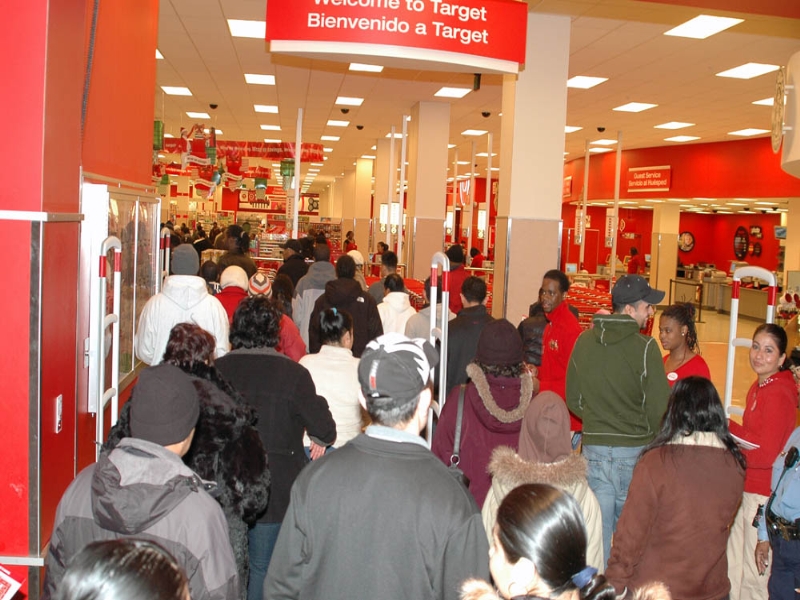The History of Black Friday

The hours keep extending, the crowds keep growing and the deals keep expanding, but is it all worth it?
 Target Shoppers on Black Friday Related Links |
Black Friday, the day after Thanksgiving, is regarded by many as the beginning of the Christmas shopping season. While not a federal holiday, several states observe the day after Thanksgiving as a holiday, which means many state and school employees have the day off. Therefore, the number of potential shoppers greatly increases.
In fact, since 2005, Black Friday has been the busiest shopping day of the year. With retailers extending their hours and deals every year, the crowds and chaos show no signs of decreasing. Here's a look at the history and evolution of Black Friday.
Big Friday?
The term Black Friday was first used in the United States to describe a financial crisis in 1869. On September 24, 1869, a Friday, James Fish and Jay Gould tried to take over the gold market in the New York Gold Exchange. The first time Black Friday referred to shopping the day after Thanksgiving was in this 1961 Philadelphia public relations newsletter:
- For downtown merchants throughout the nation, the biggest shopping days normally are the two following Thanksgiving Day. Resulting traffic jams are an irksome problem to the police and, in Philadelphia, it became customary for officers to refer to the post-Thanksgiving days as Black Friday and Black Saturday. Hardly a stimulus for good business, the problem was discussed by the merchants with their Deputy City Representative, Abe S. Rosen, one of the country's most experienced municipal PR executives. He recommended adoption of a positive approach which would convert Black Friday and Black Saturday to Big Friday and Big Saturday.
Although many merchants opposed the negative name for the biggest shopping day of the year, the term stuck. By 1975, it appeared in The New York Times: Philadelphia police and bus drivers call it Black Friday - that day each year between Thanksgiving Day and the Army-Navy Game.
Billion Dollar Friday
For years, retailers would open their doors at 6:00 a.m. on Black Friday. However, in the late 2000s, many began opening at 5:00 or 4:00 a.m., to increase shopping hours and, therefore, profits. In 2011, Best Buy, Kohl's, Macy's, Target and other leading retailers opened at midnight for the first time. The following year, Walmart, along with several other retailers, announced that they would open at 8:00 p.m. on Thanksgiving Day. In 2013, Walmart announced it would open even earlier, at 6:00 p.m. Several other retailers followed suit. Kmart took it one step further, announcing that it would open at 6:00 a.m. on Thanksgiving Day and would remain open for 41 hours straight. After their announcement, some people took to Kmart's Facebook page, commenting that the store's decision was "greedy," "shameful" and "disgusting." Some states, such as Massachusetts, have blue laws prohibiting stores to open on Thanksgiving. In those states, retailers open at midnight.
The reason for extending the hours is obvious. Major retailers like Walmart make an estimated five billion dollars on Black Friday. However, there are drawbacks to the increased shopping hours. About one million Walmart employees will work on Thanksgiving in 2013.
Attracts Aggressive Crowds
Another downside of Black Friday is that the huge sales also draw large, aggressive crowds all wanting the same deals. Each year there have been reports of shoppers getting trampled on while attempting to get an item before supplies run out. There have also been assaults and shootings reported.
For example, on Black Friday in 2012, two people were shot while arguing over a parking space at a Walmart in Tallahassee, Florida. In 2011, a woman used pepper spray on other shoppers, injuring at least 10 people during Black Friday shopping at a Walmart in Porter Ranch, California. That same year, a man in San Leandro, California, was shot leaving a Walmart at 1:45 a.m. after doing some Black Friday shopping.
Cyber Monday
In 2005, Cyber Monday became a term used to refer to the Monday after Black Friday. The term was based on a trend seen the two previous years. Retailers noticed that many shoppers, too busy to shop over the Thanksgiving holiday weekend, used that Monday to shop online.
With the additions and options of Cyber Monday and Black Thursday, perhaps the crowds on Black Friday will feel less competitive for that one deal and the violence will become a thing of the past. One thing is for certain, Black Friday continues to be a highly successful day for retailers.
Source: The Consumerist, Philadelphia Inquirer, The New York Times, Shopper Trak







